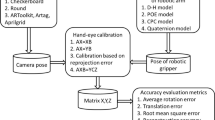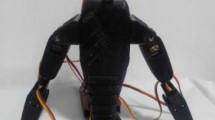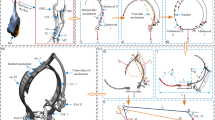Abstract
With the wide application of robot in unstructured environment, cognizing and understanding environmental information accurately is the key for robots to complete the task. Thus, visual stability problems in these robot control systems have become important design issues. In this paper, to solve the problem of vision instability caused by attitude variation of the robot working under bumpy environment, a bionic eyes system of active compensation for robot visual error is proposed inspired by the binocular VOR. The bionic vision system is developed based on features of oculomotor behaviors and bionic control algorithm of the binocular VOR. According to the behaviors features of eye movement, the bionic eye mechanism is designed by using a 3-DoF spherical parallel mechanism(SPM). Meanwhile, to improve the performance, the mechanism parameters of SPM are optimized by utilizing the worst-case performance index as the optimizing target in required workspace. An adaptive control model of the binocular VOR is established on neural control mechanisms of eye movement, and the model is used as the bionic control algorithm to drive and control the eye mechanism. The results indicate that the model can actively compensate the visual errors from postural changes of robot. Physical robot experiments also show that the system is robust even with bumpy environment.
Similar content being viewed by others
References
Chen, S., Li, Y., Kwok, N.M.: Active vision in robotic systems: a survey of recent developments [J]. Int. J. Robot. Res. 30(11), 1343–1377 (2011)
Wang, X., et al.: Design and kinematic analysis of a novel humanoid robot eye using pneumatic artificial muscles [J]. J. Bionic Eng. 5(3), 264–270 (2008)
Chen, H.P., Shen, X.J., Li, X.F., Jin, Y.S.: Bionic mosaic method panoramic image based on compound eye of fly [J]. J. Bionic Eng. 8(4), 440–448 (2011)
Wolfe, T.B., Faulkner, M.G., Wolfaardt, J.: Development of a shape memory alloy actuator for a robotic eye prosthesis [J]. Smart Mater. Struct. 14, 759–768 (2005)
Schultz, J., Ueda, J.: Nested Pizezoelectric cellular actuators for a biologically inspired camera positioning mechanism [J]. In: Proceedings of the IEEE/RSJ International Conference on Intelligent Robots and Systems, pp. 1962-1967 (2011)
Lee, Y.C., Lan, Y.C., Chu, C.Y., et al.: A Pan-Tilt orienting mechanism with parallel axes of flexural actuation [J]. IEEE/ASME Trans. Mechatron. 18(3), 1100–1112 (2013)
Lee, J.S., Kim, D.K., Baek, S.W., et al.: Newly structured double excited two-degree-of- freedom motor for security camera [J]. IEEE Trans. Magn. 44(11), 4041–4044 (2008)
Masahiko, H., Tomoaki, M., Shigeki T.: Development of spherical ultrasonic motor as a camera Actuator for pipe inspection robot [C]. In: Proceedings of the 2009 IEEE /RSJ International Conference on Intelligent Robots and Systems, pp. 2379–2384 (2009)
Gu, J., Meng, M., Cook, A., Faulkner, M.G.: A study on natural movement of artificial eye implant [J]. Robot. Auton. Syst. 32(2), 153–161 (2000)
Giorgio, C., Marco, M.: Models for the design of bioinspired robot eyes [J]. IEEE Trans. Robot. 24(1), 27–44 (2008)
Villgrattner, T., Ulbrich, H.: Design and control of a compact high-dynamic camera-orientation system [J]. IEEE/ASME Trans. Mechatron. 16(2), 221–231 (2010)
Cosselin, C.M., Pierre, E.St., Gagne, M.: On the development of the agile eye [J]. IEEE Robot. Autom. Mag. 3(4), 29–37 (1996)
Bang, Y.B., Paik, J.K., Shin, B.H., Lee, C.: A three-degree-of freedom anthropomorphic oculomotor simulator [J]. Int. J. Control. Autom. Syst. 4(2), 227–235 (2006)
Robinson, D.A., Gordon, J.L., Gordon, S.E.: A model of the smooth pursuit eye movement system [J]. Biolog. Cybern. 55(1), 43–57 (1986)
Zhang, X.L., Wakamatsu, H.: A unified adaptive oculomotor control model [J]. Int. J. Adapt. Control. Signal Process. 15(7), 697–713 (2001)
Green, A.M., Angelaki, D.E.: Internal models and neural computation in the vestibular system [J]. Exp. Brain Res. 200(3–4), 197–222 (2010)
Jean, L., Angelaki, D.E: The functional significance of velocity storage and its dependence on gravity [J]. Exp. Brain Res. 210(3–4), 407–422 (2011)
Cova, A.C., Galiana, H.L.: A bilateral model integrating vergence and the vestibule-ocular reflex [J]. Exp. Brain Res. 107(3), 435–521 (1996)
Khojasteh, E., Galiana, H.L.: A nonlinear model for context-dependent modulation of the binocular VOR [J]. IEEE Trans. Biomed. Eng. 33(6), 986–995 (2006)
Wilbur, W.P.C., Galiana, H.L.: A nonlinear model of the neural integrator improves detection of deficits in the human VOR [J]. IEEE Trans. Biomed. Eng. 57(5), 1012–1023 (2010)
Ito, M.: Cerebellar circuitry as a neuronal machine [J]. Prog. Neurobiol. 78(3–5), 272–303 (2006)
Ito, M.: Functional roles of neuropeptides in cerebellar circuits [J]. Neurosci. 162(3), 666–672 (2009)
Tsagarakisa, N.G., Mettab, G., Sandinic, G., et al.: ICub: the design and realization of an open humanoid platform for cognitive and neuroscience research [J]. Adv. Robot. 21(10), 1151–1175 (2007)
Cecilia, L., Francesco, P., Eliseo, S.M., et al.: An anthropomorphic robotic head for investigating gaze control [J]. Adv. Robot. 22(1), 57–89 (2008)
Eliseo, S.M., Luigi, M., Cecilia, L., Paolo, D.: Bioinspired velocity control of fast gaze shifts on a robotic anthropomorphic head [J]. Adv. Robot. 25(1–2), 37–58 (2008)
Lubin, K., Stephane, V., Nicolas, F.: Steering by gazing: an efficient biomimetic control strategy for visually guided micro aerial vehicles [J]. IEEE Trans. Robot. 26(2), 307–319 (2010)
Gu, Y.Z., Sato, M., Zhang, X.L.: An active stereo vision system based on neural pathways of human binocular motor system [J]. J. Bionic Eng. 4, 185–192 (2007)
Lenz, A., Balakrishnan, T., Pipe, A.G., et al.: An adaptive gaze stabilization controller inspired by the vestibule-ocular reflex [J]. Bioinspiration & Biomimetics 3(035001), 1–11 (2008)
Dean, P., Anderson, S., Porrill, J., Jörntell, H.: An adaptive-filter model of cerebellar zone C3 as a basis for safe limb control? [J]. J. Physiol. 592.22, 5459–5474 (2013)
Porrill, J., Dean, P., Anderson, S.: Adaptive filters and internal models: multilevel description of cerebellar function[J]. Neural Netw. 47, 134–149 (2013)
Dean, P., Porrill, J., et al.: The cerebellar microcircuit as an adaptive filter: experimental and computational evidence [J]. Nat. Rev. Neurosci. 11, 30–43 (2010)
Lenz, A., Anderson, S.R., Pipe, A.G., et al.: Cerebellar-inspired adaptive control of a robot eye actuated by pneumatic artificial muscles [J]. IEEE Trans. Syst. Man Cybern. Part B 39(6), 1420–1433 (2009)
Guitton, D., Volle, M.: Gaze control in humans: eye-head coordination during orienting movements to targets within and beyond the oculomotor range [J]. J. Neurophysiol 58(3), 427–459 (1987)
Huang, T., Zeng, X.J., Zeng, Z.P., Zhang, S.C.: Dimensional synthesis of spherical parallel manipulators [J]. Prog. Nat Sci. 11(1), 50–57 (2001)
LI, H.Y., Luo, J., et al.: Active compensation method of robot visual error based on Vestibule-ocular Reflex [J]. Robot. 33(1), 191–197 (2011)
Shibata, T., Schaal, S.: Biomimetic gaze Stabilization based on feedback-error-learning with nonparametric regression networks [J]. Neural Netw. 14(2), 201– 216 (2001)
Author information
Authors and Affiliations
Corresponding author
Rights and permissions
About this article
Cite this article
Li, H., Luo, J., Huang, C. et al. Design and Control of 3-DoF Spherical Parallel Mechanism Robot Eyes Inspired by the Binocular Vestibule-ocular Reflex. J Intell Robot Syst 78, 425–441 (2015). https://doi.org/10.1007/s10846-014-0078-x
Received:
Accepted:
Published:
Issue Date:
DOI: https://doi.org/10.1007/s10846-014-0078-x




